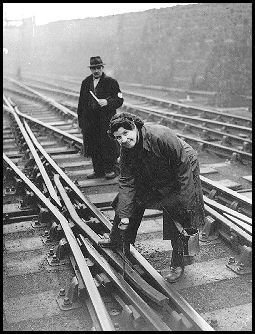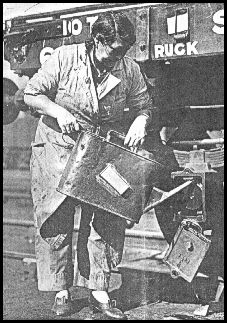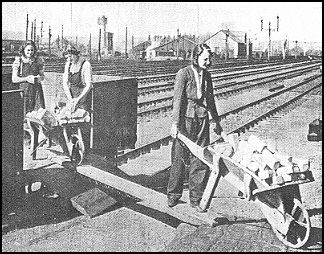FIND OUT
MORE ABOUT
RAILWAYWOMEN
THE SECOND WORLD WAR
TRACK WORK
Read track workers' reminiscences
Mrs. Lovsey, points oiler at Woodford, LNER, oiled four marshalling yards
and the junctions with the LMS and GWR. This included about 300 sets of points
over 90 acres, which she traversed every day carrying an oval oil bucket
and a long-handled brush.
Points Oiler, Middlesbrough 1941.

"I had to climb signal gantries and use "arm oil" to clean the signal arms
and the signalman would tease me by waggling the signal arm up and down.
To oil the signalling system I had to walk through the tunnels stepping from
sleeper to sleeper and holding a stick against the walls. If a train came
I would step into a recess in the wall and wait for it to pass at high speed.
My linesman would put his arms outstretched across me to prevent my being
sucked in by the rush. Sometimes I got a ride on an engine and had a go
at stoking the fire. They were happy days."
Evelyn Mack
Great Western Civil Engineer's points oiler, c.1942.
Trackwomen at Darlington, tightening the bolts, c.1944.
Mrs. Phelps oiling a truck, SR 1942.
GWR Civil Engineering labourers unloading permanent-way stores, c.1943.
Scraping the rust off a bridge before repainting, c 1942.





"I was the smallest painter in the gang. We had to move ladders,
and mix our own paint which came in cans like milk churns.
We painted Queen's Road bridge, all we had was swinging irons hooked over
the girders with just a scaffold board to walk on; no scaffolding like now.
We painted Rye river bridge including the underside. There was a very high tide
overnight and we had to go and rescue the scaffold boards from down the river."
Mrs. "Titch" Breeds, Structures Painter, Hastings, SR.
| Find out about the book |